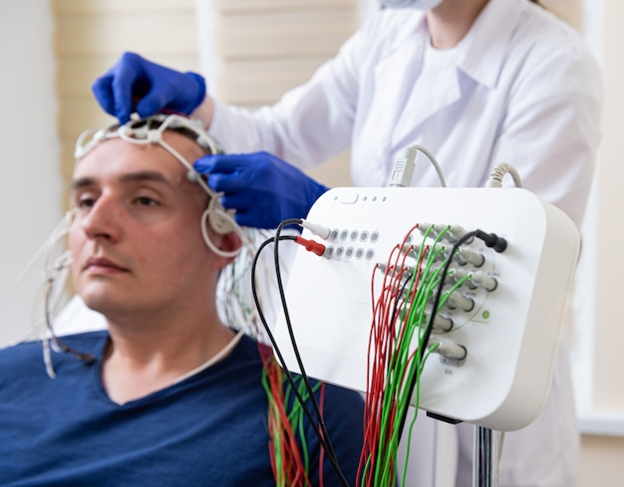Electroencephalography, or EEG, might sound like a mouthful, but it’s a straightforward way to get a peek into how your brain works. Whether you’re preparing for your first EEG test or are just curious about what it entails, understanding this common yet fascinating tool can be enlightening. Here’s everything you need to know to feel comfortable and informed before you embark on this journey into your brain’s electrical activity.
Introduction to EEG
Have you ever wondered how doctors figure out what’s going on in your brain without actually looking inside? That’s where an EEG comes in. EEG is a test that uses small sensors, known as electrodes, to measure the electrical activity of your brain. Think of it as a way to listen to the brain’s chatter. This test is crucial because it helps doctors diagnose conditions such as epilepsy by revealing unusual brain activity patterns. Moreover, EEG is a handy tool for researchers who want to learn more about how the brain functions during various tasks, like sleeping or solving problems. For anyone getting ready to have their first EEG or curious about this technology, this guide aims to explain its purpose in a simple and approachable way.
Understanding EEG Technology and Signals
The EEG test involves placing small, round sensors on your scalp to detect electrical signals from your brain. These sensors, or electrodes, are very gentle and simply look for electrical activity, so there’s nothing to worry about. When large groups of neurons—the cells that chatter in your brain—fire together, they create patterns or signals that can be measured. There’s a specific system called the “10/20 rule” which ensures that these electrodes are placed accurately on your head. This standard positioning is crucial because it helps achieve consistent results, making it easier for doctors to interpret what’s happening in your brain on the day of your EEG test.
Preparing for Your First EEG Test
Preparing for an EEG is simple and painless. Here are some steps to make sure you’re ready:
- Clean Hair: Wash your hair the night before because having clean, dry hair helps with electrode placement.
- Avoid Products: Skip styling products like gels, sprays, or creams since they can interfere with the readings.
- Stay Relaxed: Try to keep calm; feeling anxious or stressed might alter how the signals are read.
- Skip Caffeine: Avoid drinks like coffee or caffeinated sodas a few hours before your test as they could affect your brain’s activity.
On the day of the test, you’ll be in a clinic with a friendly technician who will guide you through the process. It’s normal to feel a mix of emotions, ranging from curiosity to anxiety. Remember, EEG tests are non-invasive and you won’t feel the electrodes on your scalp.
During the test, you’ll want to focus on being comfortable. Practicing relaxation techniques might help you feel more at ease. It’s as simple as breathing slowly or thinking happy thoughts. Your comfort is key to making sure the EEG can accurately capture what it needs to.
Clinical Significance of EEG
The EEG is an essential tool in diagnosing several brain-related conditions. For instance:
- Diagnosing Epilepsy: Doctors can use EEG to spot patterns that indicate seizure activity, helping confirm an epilepsy diagnosis.
- Sleep Disorders: With EEG, analyzing different stages of sleep helps understand issues like insomnia or sleep apnea, which affect your rest quality.
- Neuro-related Issues: When serious conditions such as encephalopathy, a kind of brain damage, might be present, the EEG is useful for early detection.
Decoding EEG Results and Follow-Up
After your EEG test, there are several things to look out for:
- Understanding Waveforms: Your test results will display different waveforms, including frequency and amplitude, which can tell doctors a lot about brain health.
- Common Abnormalities: Certain patterns, like those associated with seizures or other disorders, might stand out.
- Post-Test Procedures: Once your results are ready, you’ll meet with your doctor to go over the findings. This meeting might involve discussing next steps or scheduling more tests if necessary.
Advancements and Misconceptions About EEG
The world of EEG has come a long way:
- Evolution of EEG: Once reliant on large, cumbersome machines, today’s EEG devices can be more portable and user-friendly, making access much easier.
- Debunking Myths: It’s important to know that EEG is completely safe. No electricity enters your body; the test only listens to your brain.
- Technological Innovations: The horizons for EEG applications are expanding beyond medical diagnostics, potentially venturing into fields like education or personal health.
Conclusion: Embracing EEG for a Healthier Future
The EEG is a vital tool in understanding and diagnosing brain health. As technology advances, it continues to offer promising applications in various fields, including gaming and education. If you’re preparing for an EEG test, rest assured that it’s a safe and insightful way to assess your brain’s well-being. Embrace the insights an EEG provides, which can play a significant role in maintaining and improving your health. By undertaking this journey, you’re taking a proactive step towards understanding your brain better, promoting a healthier future.
Schedule your test today at Magnus diagnostic centre!



